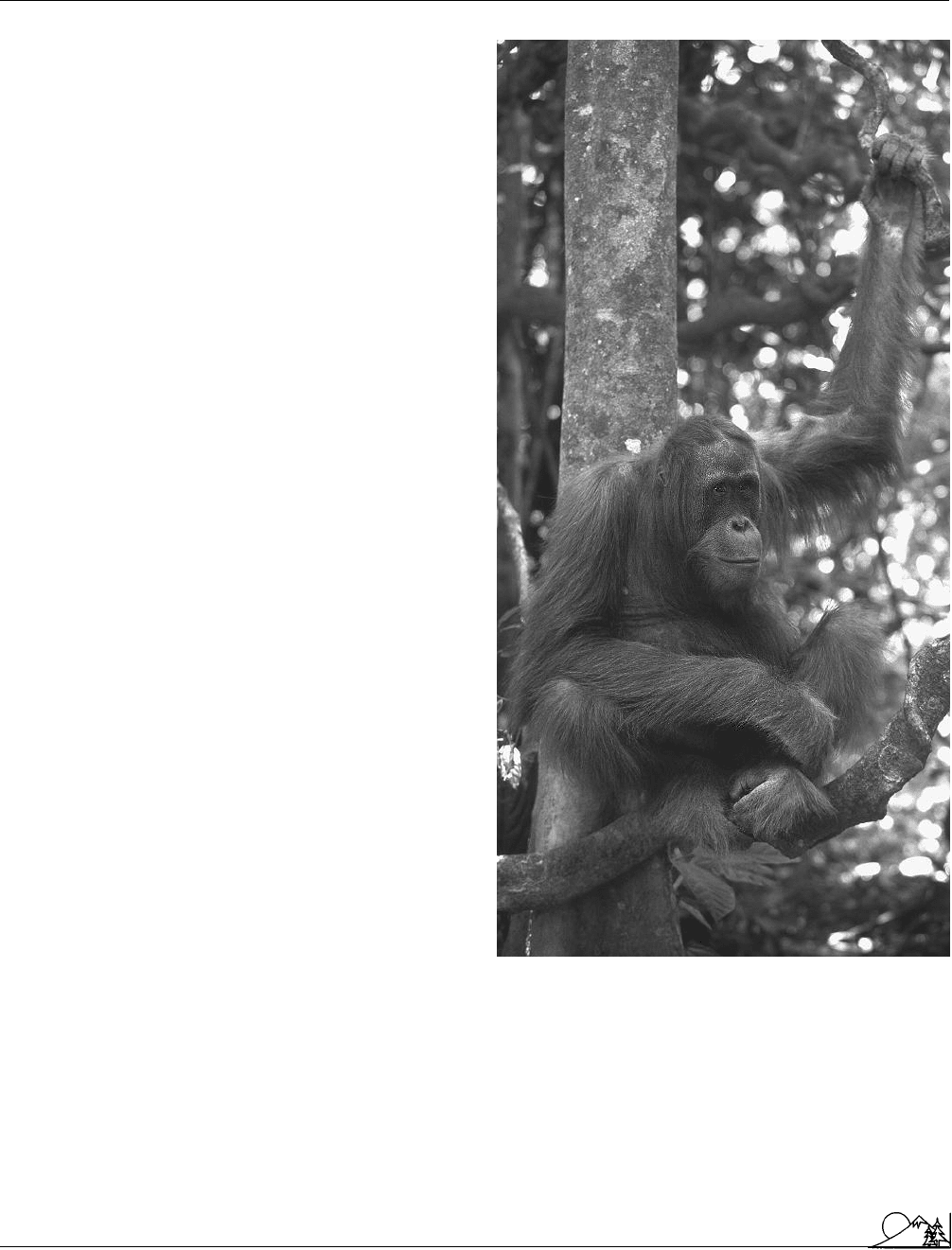Environmental Encyclopedia
Подождите немного. Документ загружается.


Environmental Encyclopedia 3
Old-growth forest
logical and regulatory purposes. The task was complicated
by the great diversity in forest types, as well as by different
views of the purpose and use of the definition. For example,
60 years of age might be considered old for one type, whereas
200 or 1,000 years might be more accurate for other types.
Moreover, forest attributes other than age are more impor-
tant for the wellbeing of certain
species
which are dependent
on forests commonly considered old growth, such as the
northern spotted owl
and marbled murrelet. Nonetheless,
some common attributes and criteria were developed.
Old-growth forests are now defined as those in a late
seral stage of ecological succession, based on their composi-
tion, structure, and function. Composition is the representa-
tion of plant species—trees, shrubs, forbs, and grasses—that
comprise the forest. (Often, in referring to an old-growth
stand foresters limit composition to the tree species present).
Structure includes the concentration, age, size, and arrange-
ment of living plants, standing dead trees (called “snags"),
fallen logs, forest-floor litter, and stream debris. Function
refers to the forest’s broad ecological roles, such as
habitat
for terrestrial and aquatic organisms, a repository for genetic
material, a component in the hydrologic and biogeochemical
cycles, and a climatic
buffer
. Each of these factors vary and
must be defined and evaluated for each forest type in the
various physiographic regions, while accounting for differ-
ences in disturbance history, such as wildfires, landslides,
hurricanes, and human activities. The problem of specifically
defining and determining use of these lands is exceedingly
complex, especially for managers of multiple-use public lands
who often are squeezed between the opposing pressures of
commercial interests, such as the timber industry, and envi-
ronmental preservation groups. The modern controversy
centers primarily around forests in the northwest of United
States and Canada—forests consisting of virgin
redwoods
,
Douglas firs, and mixed conifers.
As an example of old-growth characteristics, the
Douglas-fir forests are characterized by large, old, live trees,
many more than 150 feet (46 m) tall, 4 ft (1.2 m) in diameter,
and 200 years old. Interspersed among the trees are snags
of various sizes—skeletons of trees long dead, now home to
birds, small climbing mammals, and insects. Below the giants
are one or more layers of understory—subdominant and
lower growing trees of the same or perhaps different species,
and beneath them are shrubs, either in a thick tangle provid-
ing dense cover and blocking passage or separated and
allowing easy passage. The trees are not all healthy and
vigorous. Some are malformed, with broken tops or multiple
trunks, and infected by fungal rots whose conks protrude
through the bark. Eventually, these will fall, joining others
that fell decades or centuries ago, making a criss-cross pattern
of rotting logs on the forest floor. In places, high in the
trees, neighboring crowns touch all around, permanently
1027
shading the ground; elsewhere, gaps in the canopy allow
sunlight to reach the forest floor.
Proponents of harvesting mature trees in old-growth
forests assert that the forests cannot be preserved, that they
have reached the
carrying capacity
of the site and the stage
of decadence and declining productivity that ultimately will
result in loss of the forests as well as their high commercial
value which supports local lumber-based economies. They
feel that society would be better served by converting these
aged, slow-growing ecosystems to healthy, productive, man-
aged forests. Management proponents also argue that ade-
quate old-growth forests are permanently protected in desig-
nated wildernesses and national and state parks. Moreover,
they point out that even though most old-growth forests are
on
public land
, many forests are privately owned, and that
land owners not only pay taxes on the forests, but they also
have made an investment from which they are entitled a
reasonable profit. If the forests are to be preserved, land
owners and others suffering loss from the preservation should
be reimbursed.
Proponents of saving the large old trees and their
environments claim that the forests are dynamic, that al-
though the largest, oldest trees will die and rot, they also
will be returned to earth to support new growth, foster
biological diversity, and preserve genetic linkages. Moreover,
protection of the forests will help ensure survival of depen-
dent species, some of which are threatened or endangered.
Defenders claim that the trees will not be wasted; they simply
will have alternative value. They believe that their cause is
one of moral as well as biological imperative. More than 90%
of America’s old-growth forests have been logged, depriving
future generations
of the scientific, social, and psychic
benefits of these forests. As a vestige of North American
heritage, the remaining forests, they believe, should be ma-
nipulated only insofar as necessary to protect their integrity
and minimize threats of natural fire or disease from spreading
to surrounding lands. See also American Forestry Associa-
tion; Endangered species; National forest; National Forest
Management Act; Restoration ecology
[Ronald D. Taskey]
R
ESOURCES
B
OOKS
Arrandale, T. The Battle for Natural Resources. Washington, DC: Congres-
sional Quarterly, Inc., 1983.
Kaufmann, M. R., W. H. Moir, and R. L. Bassett. Old-Growth Forests in
the Southwest and Rocky Mountain Regions. Proceedings of a Workshop.
Washington, DC: U.S. Forest Service, Rocky Mountain Forest and Range
Experiment Station, 1992.
O
THER
Spies, T. A., and J. F. Franklin. “The Structure of Natural Young, Mature,
and Old-Growth Douglas-Fir Forests in Oregon and Washington.” In

Environmental Encyclopedia 3
Oligotrophic
Wildlife and Vegetation of Unmanaged Douglas-Fir Forests, edited by L. F.
Ruggiero, et al. Washington, DC: U. S. Forest Service, Pacific Northwest
Forest and Range Experiment Station, 1991.
Oligotrophic
The term oligotrophic is derived from the Greek term
meaning “poorly nourished” and refers to an aquatic system
that has low overall levels of primary production, principally
because of low concentrations of the nutrients that plants
require. The bottom waters of an oligotrophic lake do not
become depleted of oxygen in summer, when rates of
pri-
mary productivity
in surface waters of the lake are typically
at their highest. Oligotrophic bodies of water tend to have
a more diverse community of
zooplankton
than waters with
high levels of primary production. The term can also be used
to describe any organism that only needs a limited supply
of nutrients, or an insect that only utilizes a few plants as
habitat
.
[Marie H. Bundy]
Frederick Law Olmsted Sr. (1822 –
1903)
American landscape designer
The famous landscape designer of Central Park (on which
he collaborated with the architect Calvert Vaux), Frederick
Law Olmsted Sr. is widely known for that accomplishment
alone. Considering the impact of the park on city life in
New York, and on other designs around the world, that
would be accomplishment enough. But Olmsted other
achievements are so overshadowed by the Central Park proj-
ect, that he is still not as well known in environmental circles
as he should be.
Many people don’t know, or are confused by, the fact
that there were two Frederick Law Olmsteds: father and
son, F. L. O Sr., and F. L. O Jr. Both of them were landscape
architects, and F. L. O Jr. followed directly in his father’s
footsteps, assuming “leadership of the country’s largest and
most prestigious landscape architecture firm” after his fa-
ther’s death.
Olmsted Sr., was born in “the rural environs” of Hart-
ford, Connecticut, the oldest son of a well-to-do merchant,
from an old New England family. He was educated in a
series of boarding schools in the rural Connecticut area where
he grew up. More unorthodox educational benefits accrued
from his apprenticeships as civil engineer and farmer along
with his stint as a ship’s cabin boy on a trip to China.
Reportedly, Olmsted’s firm laid out some 1,000 parks
in 200 cities. He also designed university campuses (U.C.
1028
Berkeley, Harvard, Amherst, Yale, etc.), cemeteries, hospital
grounds (including the grounds for the hospital where he
died, unhappy—even while suffering a terminal illness—
that his plans for the hospital had not been followed carefully
enough). A source of unhappiness in general was the fact
that many of his plans were modified in ways he did not
agree with (e.g., Stanford University), or even suppressed,
as happened with his plan for
Yosemite National Park
.
The crown jewel of Olmsted’s creativity is, of course,
Central Park in New York City. As Bill Vogt describes it:
“the entire area was man-made, literally from the ground
up. It sprang from an 843-acre eyesore of stinking quagmire,
rubbish heaps, rocky outcroppings, and squatters shacks.”
An army of workers created a lake, shoveled in enormous
quantities of top
soil
to create natural-appearing meadows,
and planted whole forests to screen the park from the city.
Charles McLaughlin, the editor of Olmsted’s papers,
claimed that one of the reasons Olmsted was virtually forgot-
ten for so long was that his designs have an “always been
there” quality, resulting in landscapes that today “in their
maturity...appear so ’natural’ that one thinks of them as
something not put there by artifice but merely preserved by
happenstance.” What Olmsted and Vaux created stands to-
day as an oasis and respite from what Olmsted described as
the city’s “constantly repeated right angles, straight lines,
and flat surfaces.”
Among Olmsted’s lesser known accomplishments
were both his role in the Commission to establish Yosemite
Park (a task undertaken in 1864, long before
John Muir
first saw Yosemite Valley) and preserve Niagara Falls, a
movement which resulted in creation of the Niagara Falls
State Reservation in 1888. He also was a prominent partici-
pant in the campaign to preserve the Adirondack region in
upstate New York.
Even less well known are his writings not directly
associated with landscape architecture or ecological design.
Olmsted was quite an accomplished travel writer, producing
still readable books like a Saddle-trip on the Southwestern
Frontier of Texas, or his first book titled Walks and Talks of
an American Farmer in England. Olmsted’s travels in the
South were as a roving journalist for the New York [Daily]
Times; he was an acute observer and his travel books on the
south were also commentaries on the institution of slavery
(that he believed “to be both economically ruinous and mor-
ally indefensible.") Books from this period included The
Cotton Kingdom: A Traveler’s Observations on Cotton and
Slavery in the American Slave States, A Journey in the Seaboard
Slave States, and Slavery and the South, 1852–1857.Hewas
also a founder of the liberal journal of commentary, The
Nation. He never dissociated his design work from its social
context (believing, in his words, that his works should have “a
manifest civilizing effect"), and his biggest disappointments

Environmental Encyclopedia 3
Open marsh water management
occurred when he was not allowed to incorporate his ideas
on social change into his various designs.
[Gerald L. Young Ph.D.]
R
ESOURCES
B
OOKS
Beveridge, C. E., and P. Rocheleau. Frederick Law Olmsted: Designing the
American Landscape. New York: Rizzoli, 1995.
Fein, A. Frederick Law Olmsted and the American Environmental Tradition.
New York: George Braziller, 1972.
Hall, L. Olmsted’s America. Boston: Little, Brown, 1995.
Kalfus, M. Frederick Law Olmsted: The Passion of a Public Artist. New York:
New York University Press, 1990.
Olmsted, F. L. The Papers of Frederick Law Olmsted. Ed. C. C. McLaughlin.
Baltimore: The Johns Hopkins University Press, 1977.
White, D. F. “Frederick Law Olmsted, Placemaker.” Two Centuries of
American Planning. Ed. Daniel Schaffer. Baltimore: The Johns Hopkins
University Press, 1988.
Onchocerciasis
see
River blindness
OPEC
see
Organization of Petroleum Exporting
Countries
Open marsh water management
Open Marsh Water Management (OMWM) refers to the
practice of controlling the mosquito population in salt
marshes by creating an appropriate
habitat
for the natural
enemies of the mosquitoes; and by reducing
flooding
in
areas that are not wet on an ordinary basis—thus reducing
an
environment
that would support mosquitoes but not
their predators. Without use of
chemicals
that might be
harmful to the
natural resources
surrounding the water
body, as well as harmful to
wildlife
and humans, OMWM
calls on nature’s own ecological balance in order to success-
fully alter the pest—mosquito. The techniques were eventu-
ally employed by individuals and municipalities in order to
control mosquitoes even in their own backyards, no matter
how far that might be from tidal
wetlands
.
Before this plan was developed, and first used in New
Jersey to control the mosquito problem in their tidal wetlands
and marshes, the normal practice utilized a network of
ditches. Under this method, which started around the time
of the Civil War, the shallow ponds and water pools, the
natural habitats of the birds and fish that fed on mosquitoes
were changed or destroyed through ditch digging to drain
the marshes and remove standing water. According to the
1029
Conservationist in an article published in June 1997, the
digging also created a problem because, “Spoil generated by
the ditch digging was often disposed of in marsh areas,
creating high areas. The high areas were soon invaded by
reeds and shrubs—vegetation of lesser value for marsh wild-
life. In addition
spoil
mounds restricted the ebb and flow
of tides, reducing flushing and creating habitat that actually
favored mosquitoes. Many marshes became cut off from
tidal flow, causing them to gradually become less saline
[salty]. This resulted in changes in the composition of
flora
and
fauna
, enabling such non-native plants as the common
reed (Phragmites) to invade the marsh. While somewhat
attractive and often collected for dry plant arrangments,
this plant has little wildlife value and displaces other more
valuable species.”
The key to OMWM is creating a habitat for one
particular mosquito predator, the mummichogs, or marsh
killfish. By restoring the body of water to its natural state,
marsh killfish are provided with a habitat for survival, as are
other fish and wildlife. The killfish are small but have appe-
tites for mosquito larvae that never subside. Natural habitats
are created by the tidal flow that go between being pools of
deep water and shallow ponds. Killfish thrive under these
conditions—laying their eggs when it is dry, and hatching
them when it floods. The mosquito produces a vast number
of larvae (all waiting to emerge as mosquitoes) as soon as
the marshes are once again full of water. Yet simply produc-
ing more killfish does not ensure that they will reach the
mosquitoes, and thus control the population. Again, the
Conservationist has pointed out that, “For a project to be
effective over a wide tidal range, the design of the tidal
channels must be carefully tailored to the specific conditions
of the marsh. Shallow access channels are constructed to
allow the fish access to all parts of the marsh surface. How-
ever, pool and ditch sections must provide enough water
and adequate depth to prevent excessive predation of the
fish by wading birds.”
Mosquito control in history
The state of New Jersey was the first place where
OMWM was used—and the reasons for that go as far back
as the early settlers. According to the New Jersey Mosquito
Homepage (NJMH) Yellow Fever, contracted from mosqui-
toes, was the known as the “American plague,” infecting the
Massachusetts colony as early as 1647. In 1793, Philadelphia
was hit and the city’s population was devastated. When an
army surgeon named
Walter Reed
finally traced the
virus
to the mosquito, Aedes aegypti, in 1900, the disease was
dealt a death blow like the one it once had wagered on its
victims. But the mosquito remained more than a simple
annoyance that even the window screen introduced in the
1880s could not totally erase. Humans could contract
East-
ern Equine Encephalitis
through mosquitoes, a disease of

Environmental Encyclopedia 3
Open marsh water management
epidemic proportions even into the middle half of the twenti-
eth century. Horses continue to be infected if they are not
inoculated against the disease. Mosquitoes can also transmit
heartworm disease to dogs. Even in modern-day America,
a variety of the
species
has been found to infect humans
with the deadly
West Nile Virus
causing illness and death
to wildlife and people from New York to Ohio, and down
the east coast, by 2002.
The NJMH elaborates further on the history of mos-
quito control as an early priority in that state, and others.
“Considerable public debate was given to the question
whether mosquitoes could ever be controlled. Mosquito con-
trol operations grew in some towns but not in all towns.
Newspaper battles raged when it was painfully noted that
mosquitoes ignored municipal and even state borders. Local
boards of health funded most of the extermination work.
Laws in 1906 required support for local efforts from the
state experiment station. Another law in 1912 directed the
creation of county mosquito extermination commissions to
assure full-time mosquito work With an increase in mosquito
control workers and their rapid progress, it became clear
than an organization was needed within which these workers
could discuss their problems and share their experiences.”
Following the first convention of county commission in
February 1914 in Atlantic City, the permanent organization
known as the
New Jersey Mosquito Extermination Asso-
ciation
was formed. In 1935, a regional organization was
formed with ten other states, the
Eastern Association of
Mosquito Control Workers
, from a meeting at Trenton;
it was re-named in 1944. The
American Mosquito Control
Association
remains the premier organization concerned
with mosquito control.
The common salt marsh mosquitoes include those
known as Aedes sollicitans; Aedes contator,; and, Aedes taenior-
hynchus. Adult females deposit their eggs on the marsh sur-
face, which dry for 24 hours. The egg-filled depressions fill
with water during the monthly high tides when the marsh
is flooded, causing the larvae to hatch quickly. In addition
to killfish acting as predators for the larvae, they can be
controlled through the OMWM technique of utilizing a
series of ditches to connect mosquito breeding depressions
to more permanent bodies of water. It eliminates standing
water, and also provides for predator fish to reach any mos-
quito larvae that is still there.
One example of a project to turn around the results
of the former ditch digging practice that had been used and
proven harmful(see History of to the natural environment
is a research project operating in 2000, and supervised by
the U.S.
Fish and Wildlife Service
(USFWS), Region 5,
at the Rachel Carson
Wildlife Refuge
in Maine. The
U.S.
Department of the Interior
, U.S.
Geological Survey
in-
formation system project of the Patuxent Wildlife Research
1030
Center in Laurel, MD provided a history and description
of the project. “By the 1930s, most salt marshes throughout
the northeastern United States had been ditched for mos-
quito control purposes. Documented impacts of this exten-
sive network of ditching include
drainage
of marsh pools,
lowered
water table
levels, vegetation changes, an associ-
ated trophic [feeding ] responses. To restore the ecological
functions of ditched salt marshes, while maintaining effective
mosquito control, the USFWS (Region 5) is in the process
of plugging the salt marsh ditches and establishing marsh
pools. Ditch plugging is an adaptation of the mosquito con-
trol practice known as Open Marsh Water Management.
The purpose of this proposed study is to compare and evalu-
ate marshes that have been ditch plugged with unditched
and parallet ditched marshes. Physical (tidal
hydrology
,
water table level), chemical (
soil salinity
), and ecological
(vegetation,
nekton
, marsh invertebrates, waterbirds, mos-
quito production) factors will be evaluated.” Before data
could be collected, whatever the results, this study was ex-
pected to create an established pattern for long-term salt
marsh monitoring.
East coast states, as well as areas around the country,
have engaged in OMWM not merely for simple mosquito
control; but as a part of the restoration of
estuaries
and other
wildlife management
and restoration projects. OMWM
techniques were still being refined as of 2002 as part of a
return to an ecologically-balanced system that provides for
the survival of natural resources, and for the survival of
humans and wildlife.
[Jane E. Spear]
R
ESOURCES
P
ERIODICALS
“Tidal Wetlands in New York State Diversity.” Conservationist 51, no. 6
(June 1997): 4.
O
THER
“Cape May County Mosquito Extermination Commission.” Cape May
County Web Page. 2001 [June 2002]. <http://www.capemaycountygov.net>.
“Coastal Mosquito Control in Your Neighborhood.” Norfolk County Mos-
quito Control Project. May 3, 2001 [June 2002]. <http://www.ultranet.com/
~ncmcp/>.
“Connecticut River Estuary and Tidal River Wetlands Complex.” State
of Connecticut Department of Environmental Protection. 2002 [July 2002].
<http://www.dep.state.ct.us>.
James-Pirri, Mary Jane. “Mosquito Beach Salt Marsh OMWM Restora-
tion.” Northeastern Mosquito Control Association. 2002 [July 2002]. <http://
www.nmca.org>.
Johnson, David. “Africana.” Patuxent Wildlife Research Center. July 25, 2000
[cited June 2002]. <http://www.pwrc.usgs.gov/>.
“Mosquito Breeding Habitats.” Monmouth County, NJ Web Page. 1999 [June
2002]. <http://www.visitmonmouth.com>.
Patuxent Wildlife Research Center. Research Project; Ecosystem response of
salt marshes to Open Marsh Water management (OMWM): Rachel Carson
National Wildlife Refuge (Maine). “Angolan deepwater fields emerge as

Environmental Encyclopedia 3
Opportunistic organism
world’s most exciting oil frontier.” 2001. (June 2002). <http://www.internat-
ionalspecialreports.com/>
Purdue University/Forestry and Natural Resources. Did You Know? Healthy
Wetlands Devour Mosquitoes? [cited June 2002]. <http://www.agriculture.-
purdue.edu/fnr>.
Rutgers University/Entomology. “History of Mosquito Control in New
Jersey (Where it all Began).” New Jersey Mosquito Control Homepage. [cited
June 2002]. <http://www.-rci.rutgers.edu/~insects/>.
O
RGANIZATIONS
U.S. Environmental Protection Agency, 1200 Pennsylvania Avenue, N.W.,
Washington, DC USA 20460 202-260-2090, <www.epa.gov>
U.S. Fish and Wildlife Service, Washington, D.C. USA , <www.fws.gov>
Open system
The relationship between any system and its surrounding
environment
can be described in one of three ways. In an
isolated system, neither matter nor energy is exchanged with
its environment. In a closed system, energy, but not matter,
is exchanged. In an open system, both matter and energy
are exchanged between the system and its surrounding envi-
ronment. Any
ecosystem
is an example of an open system.
Energy can enter the system in the form of sunlight, for
example, and leave in the form of heat. Matter can enter
the system in many ways. Rain falls upon it and leaves by
evaporation or streamflow, or animals migrate into the sys-
tem and leave in the form of decay products.
Opportunistic organism
Opportunistic organisms commonly refer to animals and
plants that tolerate variable environmental conditions and
food sources. Some opportunistic
species
can thrive on al-
most any available
nutrient
source: omnivorous rats, bears,
and raccoons are all opportunistic feeders. Many opportun-
ists flourish under varied environmental conditions: the com-
mon house sparrow (Passer domesticus) can survive both in
the warm, humid
climate
of Florida and in the cold, dry
conditions of a Midwestern winter. Aquatic opportunists,
often aggressive fish species, fast-spreading
plankton
, and
water plants, frequently tolerate fluctuations in water
salin-
ity
as well as temperature.
A secondary use of the term “opportunistic” signifies
species that can quickly take advantage of favorable condi-
tions when they arise. Such species can postpone reproduc-
tion, or even remain dormant, until appropriate tempera-
tures, moisture availability, or food sources make growth and
reproduction possible. Some springtime-breeding lizards in
Australian deserts, for example, can spend months or years
in a juvenile form, but when temperatures are right and a
rare rainfall makes food available, no matter what time of
year, they quickly mature and produce young while water is
1031
still available. More familiar opportunists are viruses and
bacteria that reside in the human body. Often such organisms
will remain undetected with a healthy host for a long time.
But when the host’s immune system becomes weak, resident
viruses and bacteria seize an opportunity to grow and spread.
Thus people suffering from malnutrition, exhaustion, or a
prolonged illness are especially vulnerable to common oppor-
tunistic diseases such as the common cold or pneumonia.
Adaptable and prolific reproductive strategies usually
characterize opportunistic organisms. While some plants can
reproduced only when pollinated by a specific, rare insect
and many animals can breed only in certain conditions and
at a precise time of year, opportunistic species often repro-
duce at any time of year or under almost any conditions.
House mice (Mus musculus) are extremely opportunistic
breeders: they can produce sizeable litters at any time of
year. Opportunistic feeding aids their ability to breed year
round; these mice can nourish their young with almost any
available vegetable matter, fresh or dry.
The common dandelion (Taraxacum officinale) is also
an opportunistic breeder. Producing thousands of seeds per
plant from early spring through late fall, the dandelion can
reproduce despite
competition
from fast-growing grass, un-
der heavy applications of chemical herbicides, and even with
the violent weekly disturbance of a lawn mower. Once ma-
ture, dandelion seeds disperse rapidly and effectively, riding
on the wind or on the fur of passing rodents. The common
housefly (Musca domestica) is also an opportunistic feeder
and reproducer—it can both feed and lay eggs on almost
any organic material as long as it is fairly warm and moist.
Because of their adaptability, opportunistic organisms
commonly tolerate severe environmental disturbances. Fire,
floods,
drought
, and
pollution
disturb or even eliminate
plants and animals that require stable conditions and have
specialized nutrient sources. Fireweed (Epilobium angustifol-
ium), an opportunist that readily takes advantage of bare
ground and open sunlight, spreads quickly after land is
cleared by fire or by human disturbance. Because they toler-
ate, or even thrive, in disturbed environments, many oppor-
tunists flourish around human settlements, actively ex-
panding their ranges as human activity disrupts the
habitat
of more sensitive animals and plants. Opportunists are espe-
cially visible where chemical pollutants contaminate habitat.
In such conditions overall species diversity usually declines,
but the population of certain opportunistic species may in-
crease as competition from more sensitive or specialized
species is eliminated.
Because they are tolerant, prolific, and hardy, many
opportunistic organisms, including the house fly, the house
mouse, and the dandelion, are considered pests. Where they
occur naturally and have natural limits to their spread, how-
ever, opportunists play important environmental roles. By

Environmental Encyclopedia 3
Orangutan
quickly colonizing bare ground, fireweed and opportunistic
grasses help prevent
erosion
. Cottonwood trees (Populus
spp.), highly opportunistic propagators, are among the few
trees able to spread into
arid
regions, providing shade and
nesting places along stream channels in deserts and dry
plains. Some opportunists that are highly tolerant of pollu-
tion are now considered indicators of otherwise undetected
chemical spills
. In such hard-to-observe environments as
the sea floor, sudden population explosions among certain
bottom-dwelling marine mollusks, plankton, and other in-
vertebrates have been used to identify
petrochemical
spills
around drilling platforms and shipping lanes. See also Adap-
tation; Contaminated soil; Environmental stress; Flooding;
Growth limiting factors; Indicator organism; Parasites; Re-
silience; Scavenger; Symbiosis
[Mary Ann Cunningham Ph.D.]
R
ESOURCES
B
OOKS
Foster, H. D. Health, Disease and the Environment. Boca Raton: CRC
Press, 1992.
P
ERIODICALS
Alexander, S. P. “Oasis Under the Ice.” International Wildlife 18 (Novem-
ber-December 1988): 32–7.
Arcieri, D. T. “The Undesirable Alien—The House Sparrow.” The Conser-
vationist 46 (1992): 24–25.
Bradshaw, S. D., H. S. Giron, and F. J. Bradshaw. “Patterns of Breeding
in Two Species of Agamid Lizards in the Arid Subtropical Pilbara Region
of Western Australia.” General and Comparative Endocrinology 82 (1991):
407–24.
Moreno, J. M., and W. C. Oechel. “Fire Intensity Effects on Germination
of Shrubs and Herbs in Southern California Chaparral.” Ecology 72 (1991):
1993–2004.
Shafir, A. “Dynamics of a Fish Ectoparasite Population: Opportunistic
Parasitism in Argulus japonicus.” Crustaceana 62 (1992): 50–64.
Orangutan
The orangutan (Pongo pygmaeus), one of the Old World
great apes, has its population restricted to the rain forests
of the Indonesian islands of Sumatra and Borneo. The
orangutan is the largest living arboreal mammal, and it
spends most of the daylight hours moving slowly and deliber-
ately through the forest canopy in search of food. Sixty
percent of their diet consists of fruit, and the remainder is
composed of young leaves and shoots, tree bark, mineral-
rich
soil
, and insects. Orangutans are long-lived, with many
individuals reaching between 50 and 60 years of age in the
wild. These large, chestnut-colored, long-haired apes are
facing possible
extinction
from two different causes:
habitat
destruction and the wild animal trade.
1032
An orangutan. (Photograph by Tim Davis. Photo Re-
searchers Inc. Reproduced by permission.)
The
rain forest ecosystem
on the islands of Sumatra
and Borneo is rapidly disappearing. Sumatra loses 370 mi
2
(960 km
2
) of forest a year, or about 1.6%, faster than any
other Indonesian island. The rest of central Indonesia, of
which Borneo comprises a major part, loses about 2,700
square miles (7,000 km
2
) per year. Some experts believe this

Environmental Encyclopedia 3
Oregon silverspot butterfly
estimate is too low, and they argue it could be closer to
4,600 mi
2
(12,000 km
2
) per year. Another devastating blow
was dealt Borneo’s rain forests just over a decade ago, when
more than 15,400 mi
2
(40,000 km
2
) of the island’s tropical
forest was destroyed by
drought
and fire between 1982 and
1983. The fire was set by farmers who claimed to be unaware
of the risks involved in burning off vegetation in a drought
stricken area. Even though Indonesia still has over 400,000
mi
2
(1,000,000 km
2
) of rain forest habitat remaining, the
rate of loss threatens the continued existence of the wild
orangutan population, which is now estimated at about
25,000 individuals.
Both the Indonesian government and the
Convention
on International Trade in Endangered Species of Wild
Fauna and Flora
(CITES) have banned international trade
of orangutans, yet their population continues to be threat-
ened by the black market. In order to meet the demand for
these apes as pets around the world, poachers kill the mother
orangutan to secure the young ones, and the
mortality
rate
of these orphans is extremely high, with less than 20% of
those smuggled ever arriving alive at their final destination.
This high mortality rate is directly due to stress, both emo-
tional and physiological, on the young orangutans. The
transportation
scheme involved in smuggling these animals
out of Indonesia to major trade centers throughout the world
is intricate and time-consuming, and the way in which they
are concealed for shipping is inhumane. These are two more
reasons why only one out of five or six orangutan babies will
survive the ordeal.
Some hope for the
species
rests in a global effort to
manage a captive propagation program in zoos. A potentially
self-sustaining captive population of more than 850 orang-
utans has been established. An elaborate system of net-
working and recording of all legally held individuals may also
aid in the recognition and recapture of smuggled animals.
Researchers have also developed methods of determining
whether smuggled orangutans are of Bornean or Sumatran
origin, thus providing a means of maintaining genetic integ-
rity for those that can be bred in captivity or relocated.
[Eugene C. Beckham]
R
ESOURCES
B
OOKS
Galdikas, M. F. Birute
´
, and Nancy Brigs. Orangutan Odyssey. New York:
Harry N. Abrams, 1999.
Russon, Anne. Orangutans: Wizards of the Rain Forest. Buffalo: Firefly
Books, 2000.
O
THER
Orangutan Sanctuary. [cited May 2002]. <http://www.yorku.ca/arusson>.
Orang-outang. [cited May 2002]. <http://www.orang-outang.com>.
1033
Order of magnitude
A mathematical term used loosely to indicate tenfold differ-
ences between values. This concept is crucial to interpreting
logarithmic scales such as
pH
or
earthquake
magnitude,
where each number differs by a factor of 10, and two numbers
differ by a factor of 100 (10 times 10). For example, a pH
of 4 is 100 times as acidic as a pH of 6 because they differ
by two orders of magnitude. Scientists often generalize with
this term; for example “our ability to measure pollutants
has improved by several orders of magnitude” means that
whereas before we were able to measure
parts per million
(ppm), we can now measure
parts per billion
(ppb).
Oregon silverspot butterfly
The Oregon silverspot butterfly (Speyeria zerene hippolyta)is
a medium-sized butterfly, predominantly orange and brown
with black veins and spots on its hindwings and bright silver
spots on its forewings. The length of its forewings is about
1.1 in (2.9 cm). The female is usually slightly larger than
the male. This butterfly is listed as threatened by the U. S.
Fish and Wildlife Service
and has been protected under
the
Endangered Species Act
since 1980.
Inhabiting a very restricted range, the Oregon sil-
verspot occurs only in salt spray meadows along the Pacific
coast in Oregon and Washington. This
habitat
is character-
ized by heavy rainfall, fog, and mild temperatures. The most
critical feature of this habitat, however, is the presence of
the western blue violet (Viola adunca), the host plant of the
butterfly’s larva. For two months each spring, larval Oregon
silverspots feed on violet leaves before entering the pupa
stage of development. This butterfly was historically present
at 17 locations along the coasts of Oregon and Washington,
but now only five populations in Oregon are known to exist
with certainty.
Housing developments and recreational uses of the
coast that destroy or degrade butterfly habitat are the major
threats to this subspecies’s survival. Natural fire patterns in
its meadow habitat have been suppressed, allowing non-
native vegetation to mix with native plants and changing
the habitat’s character. An area of Lane County, Oregon
with a healthy population of Oregon silverspots has been
designated
critical habitat
for this subspecies. Expansion
of the population of western blue violets in this area will be
encouraged by the control of saplings and other invading
plants. Transplantation of western blue violets to other sites
with suitable meadow habitat may also be attempted. A
recovery plan was put into effect in 1999 and monitored
through 2000. It was headed by Lewis and Clark College,
the Oregon Zoo in Portland, and the Woodland Park Zoo
in Seattle and consisted of rearing the larvae in captivity,

Environmental Encyclopedia 3
Organic gardening and farming
Oregon silverspot butterfly (Speyeria zerene
hippolyta). (Photograph by Paul A. Opler. Reproduced
by permission.)
then returning the butterflies to the wild. Although the
Oregon silverspot butterfly is not in immediate danger of
extinction
, its specific habitat requirements and the vulnera-
bility of that habitat to degradation and destruction, makes
intervention necessary to ensure the long-term survival of
this subspecies.
[Christine B. Jeryan]
R
ESOURCES
B
OOKS
Howe, W. H. The Butterflies of North America. Garden City, NY: Double-
day, 1975.
O
THER
U.S. Fish and Wildlife Service Revised Recovery Plan Published for the
Oregon Silverspot Butterfly. November 29, 2001 [cited May 2002]. <http://
news.fws.gov/NewsReleases/R1/C71501ED-5742-4E26-
965408A77BC0875F.html>.
Organic gardening and farming
Agriculture has changed dramatically since the end of World
War II. As a result of new technologies, mechanization, in-
creased chemical use, specialization, and government policies,
food and fiber productivity has soared. While some of these
changes have ledto positive effects, there have been significant
costs:
topsoil
depletion,
groundwater
contamination,
harmful
pesticide residue
, the decline of family farms, and
increasing costs of production.To counterbalance these costs,
there is a growing movement to grow plants organically.
On a local level, suburban homeowners and city dwell-
ers are finding ways to plant their own food for personal
consumption in plots that are not sprayed with
chemicals
1034
or treated with synthetic fertilizers. City dwellers may team
up to work a collective, organic garden on a vacant lot.
Homeowners have the option to create
mulch
piles—a mix-
ture of leaves and organic materials, vegetable leavings, egg
shells, coffee grounds, etc.—that eventually become a rich
soil
, thanks to the breakdown of these elements by tiny
organisms. This enriched soil becomes a fertile, clean foun-
dation for a bountiful garden. The inevitable weeds that
grow can be picked by hand.
On a larger level, emerging as an answer to some of
these farming problems is a movement called “sustainable
agriculture.” Sustainability rests on the principle that we
must meet the needs of the present without compromising
the ability of
future generations
to meet their own needs.
Organic farming is part of this movement. Most sig-
nificantly, organic foods are grown without synthetic fertiliz-
ers, pesticides, or herbicides. Organic farming and gardening
is the result of the belief that the best food crops come from
soil that is nurtured rather than treated. Organic farmers
take great care to give the soil nutrients to keep it healthy,
just as a person works to keep his or her body healthy with
certain nutrients. Thus, organic farmers prefer to provide
those essential soil builders in natural ways: using cover crops
instead of chemical fertilizers, releasing predator insects
rather than spraying pests with pesticides and hand weeding
rather than applying herbicides.
Organic production practices involve a variety of farm-
ing applications. Specific strategies must take into account
topography
, soil characteristics,
climate
, pests, local avail-
ability of inputs, and the individual grower’s goals. Despite
the site-specific and individual nature of this approach, sev-
eral general principles can be applied to help growers select
appropriate management practices. Growers must:
1. Select
species
and varieties of crops that are well
suited to the site and to the conditions of the farm.
2. Diversify the crops, including livestock and cultural
practices, to enhance the biological and economic
stability
of the farm.
3. Manage the soil to enhance and protect its quality.
Making the transition to
sustainable agriculture
is
a process. For farmers, the transition normally requires a
series of small, realistic steps. For example in California,
where there has been a water shortage, steps are being taken
to develop drought-resistant farming systems, even in normal
years. Farmers are encouraged to improve
water conserva-
tion
and storage measures, provide incentives for selecting
specific crops that are drought-tolerant, reduce the volume
of
irrigation
systems, and manage crops to reduce water loss.
In order to stop soil
erosion
, farmers are encouraged
to reduce or eliminate tillage, manage irrigation to reduce
runoff
, and keep the soil covered with plants or mulch.

Environmental Encyclopedia 3
Organic gardening and farming
Farmers are also encouraged to diversify, since diversi-
fied farms are usually more economically and ecologically
resilient. By growing a diversity of crops, farmers spread
economic risk and the crops are less susceptible to the infesta-
tion of certain predators that feed off one crop. Diversity can
buffer a farm biologically. For example, in annual cropping
systems, crop rotation can be used to suppress weeds, patho-
gens, and insect pests.
Cover crops can have a stabilizing effect on the agro-
ecosystem
. Cover crops hold soil and nutrients in place,
conserve soil moisture with mowed or standing dead
mulches, and increase the water
infiltration
rate and soil
water holding capacity. Cover crops in orchards and vine-
yards can buffer the system against
pest
infestations by
increasing beneficial arthropod populations and can there-
fore reduce the need for chemicals. Using a variety of cover
crops is also important in order to protect against the failure
of a particular species to grow and to attract and sustain a
wide range of beneficial arthropods.
Optimum diversity may be obtained by integrating
both crops and livestock in the same farming operation. This
was the common practice for centuries until the mid-1900s,
when technology, government policy, and economics com-
pelled farms to become more specialized. Mixed crop and
livestock operations have several advantages. First, growing
row crops only on more level land and pasture or forages
on steeper slopes will reduce soil erosion. Second, pasture
and forage crops in rotation enhance soil quality and reduce
erosion; livestock manure in turn contributes to soil fertility.
Third, livestock can buffer the negative impacts of low rain-
fall periods by consuming crop residue that in “plant only”
systems would have been considered failures. Finally, feeding
and marketing are more flexible in animal production sys-
tems. This can help cushion farmers against trade and price
fluctuations and, in conjunction with cropping operations,
make more efficient farm labor.
Animal production practices are also sustainable or
organic. In the midwestern and northeastern United States,
many farmers are integrating crop and animal systems, either
on dairy farms or with range cattle, sheep, and hog opera-
tions. Many of the principles outlined in the crop production
section apply to both groups. The actual management prac-
tices will, of course, be quite different.
Animal health is crucial, since unhealthy stock waste
feed and require additional labor. A herd health program is
critical to sustainable livestock production. Animal nutrition
is another major issue. While most feed may come from
other enterprises on the ranch, some purchased feed is usually
imported. If the animals feed from the outside, this feed
should be as free of chemicals as possible.
A major goal of organic farming is a healthy soil.
Healthy soil will produce healthy crops and plants that have
1035
optimum vigor and less susceptibility to pests. In organic or
sustainable systems, the soil is viewed as a fragile and living
medium that must be protected and nurtured to ensure its
long-term productivity and stability. Fertilizers and other
inputs may be needed, but they are minimized as the farmer
relies on natural, renewable, and on-farm inputs.
While many crops have key pests that attack even
the healthiest of plants, proper soil, water, and
nutrient
management can help prevent some pest problems brought
on by crop stress or nutrient imbalance. Additionally, crop
management systems that impair soil quality often result in
greater inputs of water, nutrients, pesticides, and/or energy
for tillage to maintain yields.
Sustainable approaches are those that are the least
toxic and least energy intensive and yet maintain productivity
and profitability. Farmers are encouraged to use preventive
strategies and other alternatives before using chemical inputs
from any source. However, there may be situations where
the use of synthetic chemicals would be more “sustainable”
than a strictly nonchemical approach or an approach using
toxic “organic” chemicals. For example, one grape grower
in California switched from tillage to a few applications of
a broad spectrum contact
herbicide
in his vine row. This
approach may use less energy and may compact the soil less
than numerous passes with a cultivator or mower.
Coalitions have been created to address the growing
organic movement concerns on a local, regional, and national
level. The Organic Food Production Association of North
America is the trade and marketing arm of the organic
industry in the United States and Canada. The Farm Bill
of 1990—Organic Foods Production Act—addressed the
growing organic farming movement. Title 21 of the bill is
the section that will be dealing with the regulations regarding
organic certification. The
U.S. Department of Agriculture
,
with the guidance of an advisory committee or National
Organic Standards Board, is in the process of establishing
the federal regulations that will standardize the rules for the
entire organic industry in the United States, from growing
and manufacturing to distribution. Presently, the organic
movement includes growers, retailers, distributors, traders,
urban and individual consumers, processors, and various
nonprofit organizations nationwide.
Until the regulations are in place, the standards estab-
lished by individual states vary, or in some states do not
exist at all. The 1990 law requires that organic farmers wait
for three years before they are officially certified—to ensure
most of the chemicals have been eliminated. With proper
documentation, on-site inspectors are then able to certify
the farm. Organic groups admit that no organic program
can claim absolutely it is residue free. The issue here is a
process—of farming and producing product in as chemically
free and healthy an
environment
as is possible.

Environmental Encyclopedia 3
Organic waste
The international community is joining the organic
movement. Europe—the European Common Market—
Australia, Argentina, and many countries in South America
are establishing their own organic standards and have joined
together under the organization called International Federa-
tion of Organic Agricultural Movements.
In addition to the upcoming United States federal
standardization of organic farming, more policies are needed
to promote simultaneously
environmental health
and eco-
nomic profitability.
For example, commodity and price support programs
could be restructured to allow farmers to realize the full
benefits of the productivity gains made possible through
alternative practices. Tax and credit policies could be modi-
fied to encourage a diverse and decentralized system of family
farms rather than corporate concentration and absentee own-
ership. Government and land grant university research could
be modified to emphasize the development of sustainable
alternatives. Congress can become more rigorous in pre-
venting the application of certain pesticides, especially those
that have been shown to be carcinogenic. Marketing orders
and cosmetic standards (i.e. color and uniformity of product,
etc.) could be amended to encourage reduced
pesticide
use.
Consumers play a key role. Through their purchases,
they send strong messages to producers, retailers, and others
in the system about what they think is important. Food
cost and nutritional quality have always influenced consumer
choices. The challenge now is to find strategies that broaden
consumer perspectives so that environmental quality and
resource use are also considered in shopping decisions. Coali-
tions organized around improving the food system are one
specific method of systemizing growing and delivery for the
producers, retailers, and consumers.
“Clean” meat, vegetables, fruits, beans, and grains are
available, as are products such as organically grown cotton.
As consumer demands increase, growers will respond. See
also Biodiversity; Monoculture
[Liane Clorfene Casten]
R
ESOURCES
B
OOKS
Conford, P., ed. Organic Tradition: An Anthology of Writings on Organic
Farming, 1900–1950. Cincinnati, OH: Seven Hills Book Distributors,
1991.
Dudley, N. G is for EcoGarden: An A to Z Guide to a More Organically
Healthy Garden. New York: Avon, 1992.
Erickson, J. Gardening for a Greener Planet: A Chemical-Free Approach. Blue
Ridge Summit, PA: TAB Books, 1992.
National Research Council. Alternative Agriculture. Washington, DC: Na-
tional Academy Press, 1989.
Rodale, R. Regenerative Farming Systems. Emmaus, PA: Rodale Press, 1985.
1036
P
ERIODICALS
Krueger, S. “Green Acres: Farmers Are Hoping Chemical-Free Crops Will
Help Get Them Out of the Red.” Nature Canada 21 (Spring 1992): 42–48.
Organic waste
Organic wastes contain materials which originated from liv-
ing organisms. There are many types of organic wastes and
they can be found in
municipal solid waste
, industrial
solid waste
, agricultural waste, and wastewaters. Organic
wastes are often disposed of with other wastes in landfills
or incinerators, but since they are
biodegradable
, some
organic wastes are suitable for
composting
and land appli-
cation.
Organic materials found in municipal solid waste in-
clude food, paper, wood, sewage
sludge
, and
yard waste
.
Because of recent shortages in
landfill
capacity, the number
of municipal composting sites for yard wastes is increasing
across the country, as is the number of citizens who compost
yard wastes in their backyards. On a more limited basis,
some mixed municipal waste composting is also taking place.
In these systems, attempts to remove inorganic materials are
made prior to composting.
Some of the organic materials in municipal solid waste
are separated before disposal for purposes other than com-
posting. For example, paper and cardboard are commonly
removed for
recycling
.
Food waste
from restaurants and
grocery stores is typically disposed of through
garbage
dis-
posals, therefore, it becomes a component of
wastewater
and sewage sludge.
A large percentage of sewage sludge is landfilled and
incinerated, but it is increasingly being applied to land as a
fertilizer
. Sewage sludge may be used as an agricultural
fertilizer or as an aid in reclaiming land devastated by
strip
mining
,
deforestation
, and over-application of inorganic
fertilizers. It may also be applied to land solely as a means
of disposal, without the intention of improving the
soil
.
The organic fraction of industrial waste covers a wide
spectrum including most of the components of municipal
organic waste, as well as countless other materials. A few
examples of industrial organic wastes are papermill sludge,
meat processing waste, brewery wastes, and textile mill fibers.
Since a large variety and volume of industrial organic wastes
are generated, there is a lot of potential to recycle and com-
post these materials. Waste managers are continually experi-
menting with different “recipes” for composting industrial
organic wastes into soil conditioners and soil amendments.
Some treated industrial wastewaters and sludges contain
large amounts of organic materials and they too can be used
as soil fertilizers and amendments.
